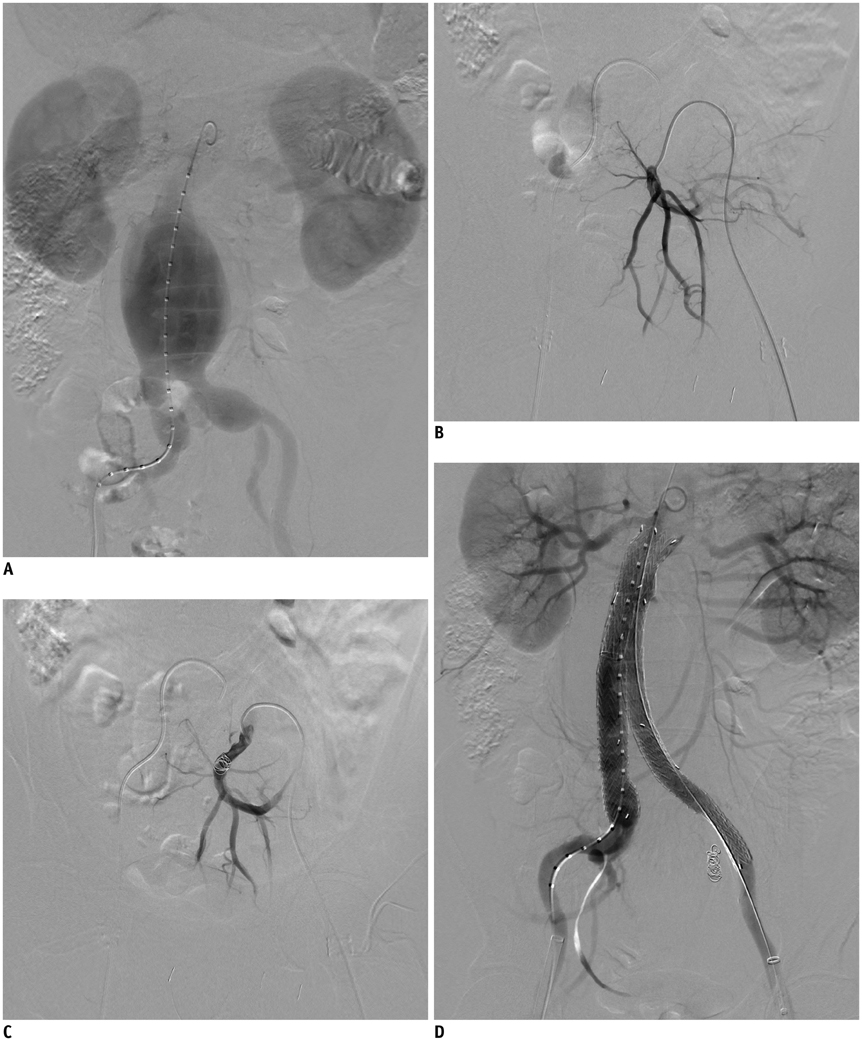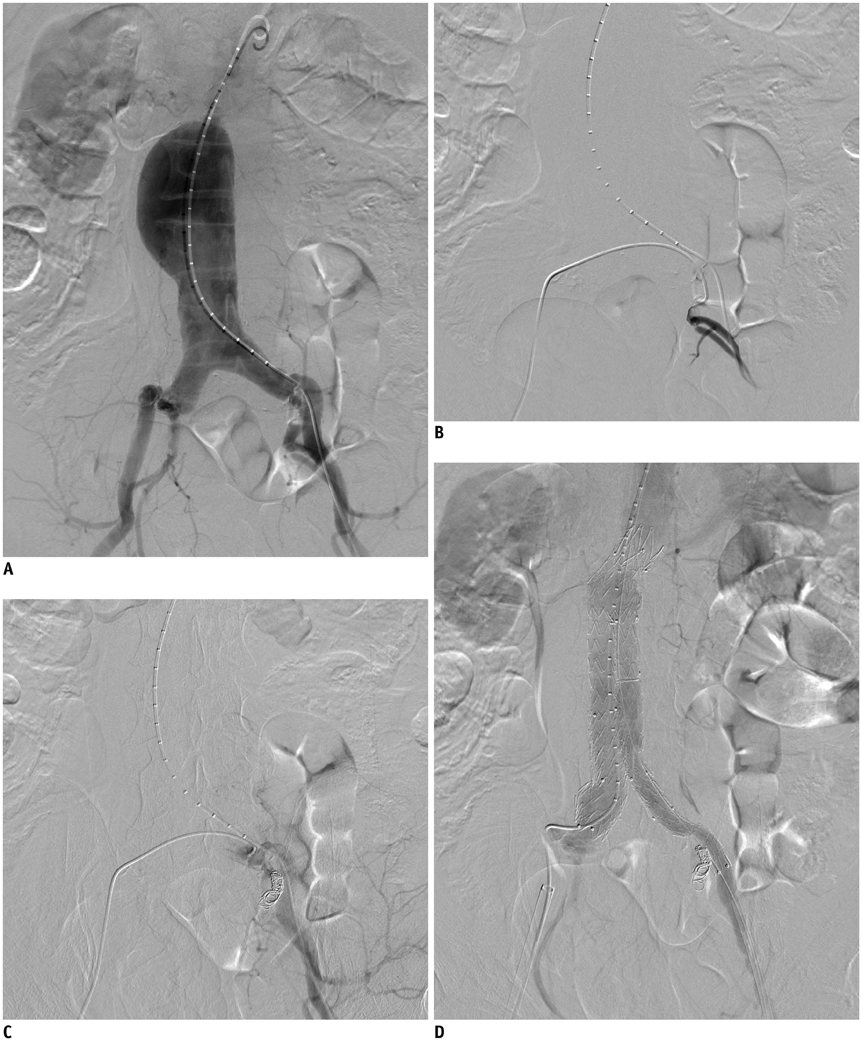Korean J Radiol.
2014 Oct;15(5):613-621. 10.3348/kjr.2014.15.5.613.
Internal Iliac Artery Embolization during an Endovascular Aneurysm Repair with Detachable Interlock Microcoils
- Affiliations
-
- 1Department of Radiology, Inha University Hospital, Inha University School of Medicine, Incheon 400-711, Korea. radjeon@inha.ac.kr
- 2Department of Vascular Surgery, Inha University Hospital, Inha University School of Medicine, Incheon 400-711, Korea.
- 3Department of Vascular and Endovascular Surgery, The Catholic University of Korea School of Medicine, Seoul 137-701, Korea.
- KMID: 1734946
- DOI: http://doi.org/10.3348/kjr.2014.15.5.613
Abstract
OBJECTIVE
The purpose of this study was to evaluate the effectiveness of detachable interlock microcoils for an embolization of the internal iliac artery during an endovascular aneurysm repair (EVAR).
MATERIALS AND METHODS
A retrospective review was conducted on 40 patients with aortic aneurysms, who had undergone an EVAR between January 2010 and March 2012. Among them, 16 patients were referred for embolization of the internal iliac artery for the prevention of type II endoleaks. Among 16 patients, 13 patients underwent embolization using detachable interlock microcoils during an EVAR. Computed tomographic angiographies and clinical examinations were performed during the follow-up period. Technical success, clinical outcome, and complications were reviewed.
RESULTS
Internal iliac artery embolizations using detachable interlock microcoils were technically successful in all 13 patients, with no occurrence of procedure-related complications. Follow-up imaging was accomplished in the 13 cases. In all cases, type II endoleak was not observed with computed tomographic angiography during the median follow-up of 3 months (range, 1-27 months) and the median clinical follow-up of 12 months (range, 1-27 months). Two of 13 (15%) patients had symptoms of buttock pain, and one patient died due to underlying stomach cancer. No significant clinical symptoms such as bowel ischemia were observed.
CONCLUSION
Internal iliac artery embolization during an EVAR using detachable interlock microcoils to prevent type II endoleaks appears safe and effective, although this should be further proven in a larger population.
Keyword
MeSH Terms
Figure
Reference
-
1. Schoder M, Zaunbauer L, Hölzenbein T, Fleischmann D, Cejna M, Kretschmer G, et al. Internal iliac artery embolization before endovascular repair of abdominal aortic aneurysms: frequency, efficacy, and clinical results. AJR Am J Roentgenol. 2001; 177:599–605.2. Ha CD, Calcagno D. Amplatzer Vascular Plug to occlude the internal iliac arteries in patients undergoing aortoiliac aneurysm repair. J Vasc Surg. 2005; 42:1058–1062.3. Murphy KD, Richter GM, Henry M, Encarnacion CE, Le VA, Palmaz JC. Aortoiliac aneurysms: management with endovascular stent-graft placement. Radiology. 1996; 198:473–480.4. Lee C, Dougherty M, Calligaro K. Concomitant unilateral internal iliac artery embolization and endovascular infrarenal aortic aneurysm repair. J Vasc Surg. 2006; 43:903–907.5. Cynamon J, Lerer D, Veith FJ, Taragin BH, Wahl SI, Lautin JL, et al. Hypogastric artery coil embolization prior to endoluminal repair of aneurysms and fistulas: buttock claudication, a recognized but possibly preventable complication. J Vasc Interv Radiol. 2000; 11:573–577.6. Marin ML, Veith FJ, Lyon RT, Cynamon J, Sanchez LA. Transfemoral endovascular repair of iliac artery aneurysms. Am J Surg. 1995; 170:179–182.7. Razavi MK, DeGroot M, Olcott C 3rd, Sze D, Kee S, Semba CP, et al. Internal iliac artery embolization in the stent-graft treatment of aortoiliac aneurysms: analysis of outcomes and complications. J Vasc Interv Radiol. 2000; 11:561–566.8. Kickuth R, Dick F, Triller J, Ludwig K, Schmidli J, Do DD. Internal iliac artery embolization before endovascular repair of aortoiliac aneurysms with a nitinol vascular occlusion plug. J Vasc Interv Radiol. 2007; 18:1081–1087.9. Harris PL, Buth J, Mialhe C, Myhre HO, Norgren L. EUROpean collaborators on Stent-graft Techniques for abdominal aortic Aneurysm Repair. The need for clinical trials of endovascular abdominal aortic aneurysm stent-graft repair: The EUROSTAR Project. J Endovasc Surg. 1997; 4:72–77. discussion 78-79.10. Cekirge HS, Saatci I, Firat MM, Balkanci F, Besim A. Interlocking detachable coil occlusion in the endovascular treatment of intracranial aneurysms: preliminary results. AJNR Am J Neuroradiol. 1996; 17:1651–1657.11. Reidy JF, Qureshi SA. Interlocking detachable platinum coils, a controlled embolization device: early clinical experience. Cardiovasc Intervent Radiol. 1996; 19:85–90.12. Sacks D, McClenny TE, Cardella JF, Lewis CA. Society of Interventional Radiology clinical practice guidelines. J Vasc Interv Radiol. 2003; 14(9 Pt 2):S199–S202.13. Armon MP, Yusuf SW, Latief K, Whitaker SC, Gregson RH, Wenham PW, et al. Anatomical suitability of abdominal aortic aneurysms for endovascular repair. Br J Surg. 1997; 84:178–180.14. Brewster DC, Geller SC, Kaufman JA, Cambria RP, Gertler JP, LaMuraglia GM, et al. Initial experience with endovascular aneurysm repair: comparison of early results with outcome of conventional open repair. J Vasc Surg. 1998; 27:992–1003. discussion 1004-1005.15. Young AT, Tadavarthy SM, Yedlicka JW Jr, Hunter DW, Becker GJ, Herrera MA, et al. Vasculary embolotherapy. In : Castañeda-Zúñiga WR, Tadavarthy SM, editors. Interventional radiology. 2nd ed. Baltimore: Williams & Wilkins;1992. p. 9–200.16. Vandy F, Criado E, Upchurch GR Jr, Williams DM, Rectenwald J, Eliason J. Transluminal hypogastric artery occlusion with an Amplatzer vascular plug during endovascular aortic aneurysm repair. J Vasc Surg. 2008; 48:1121–1124.17. Park KM, Yang SS, Kim YW, Park KB, Park HS, Do YS, et al. Clinical outcomes after internal iliac artery embolization prior to endovascular aortic aneurysm repair. Surg Today. 2014; 44:472–477.18. Nancarrow PA, Fellows KE, Lock JE. Stability of coil emboli: an in vitro study. Cardiovasc Intervent Radiol. 1987; 10:226–229.19. Krüger K, Wagner D, Gawenda M, Strohe D, Uedelhoven J, Brunkwall J, et al. [Coil embolization of arteriovenous fistulae on in situ saphenous vein bypasses: success rate and complications]. Rofo. 2007; 179:587–592.20. Goh RH, Sniderman KW, Kalman PG. Long-term follow-up of management of failing in situ saphenous vein bypass grafts using endovascular intervention techniques. J Vasc Interv Radiol. 2000; 11:705–712.21. Farahmand P, Becquemin JP, Desgranges P, Allaire E, Marzelle J, Roudot-Thoraval F. Is hypogastric artery embolization during endovascular aortoiliac aneurysm repair (EVAR) innocuous and useful? Eur J Vasc Endovasc Surg. 2008; 35:429–435.22. Mehta M, Veith FJ, Ohki T, Cynamon J, Goldstein K, Suggs WD, et al. Unilateral and bilateral hypogastric artery interruption during aortoiliac aneurysm repair in 154 patients: a relatively innocuous procedure. J Vasc Surg. 2001; 33:2 Suppl. S27–S32.23. Marks MP, Chee H, Liddell RP, Steinberg GK, Panahian N, Lane B. A mechanically detachable coil for the treatment of aneurysms and occlusion of blood vessels. AJNR Am J Neuroradiol. 1994; 15:821–827.24. Dudeck O, Bulla K, Wieners G, Ruehl R, Ulrich G, Amthauer H, et al. Embolization of the gastroduodenal artery before selective internal radiotherapy: a prospectively randomized trial comparing standard pushable coils with fibered interlock detachable coils. Cardiovasc Intervent Radiol. 2011; 34:74–80.25. Seo JM, Park KB, Kim KH, Jeon P, Shin SW, Park HS, et al. Clinical and multidetector CT follow-up results of renal artery aneurysms treated by detachable coil embolization using 3D rotational angiography. Acta Radiol. 2011; 52:854–859.26. Pellerin O, Caruba T, Kandounakis Y, Novelli L, Pineau J, Prognon P, et al. Embolization of the internal iliac artery: cost-effectiveness of two different techniques. Cardiovasc Intervent Radiol. 2008; 31:1088–1093.27. Ferro C, Rossi UG, Bovio G, Petrocelli F, Seitun S. The Amplatzer vascular plug 4: preliminary experience. Cardiovasc Intervent Radiol. 2010; 33:844–848.28. Libicher M, Pavlidis D, Bangard C, Gawenda M. Occlusion of the internal iliac artery prior EVAR: comparison of coils and plugs. Vasc Endovascular Surg. 2012; 46:34–39.29. Yano OJ, Morrissey N, Eisen L, Faries PL, Soundararajan K, Wan S, et al. Intentional internal iliac artery occlusion to facilitate endovascular repair of aortoiliac aneurysms. J Vasc Surg. 2001; 34:204–211.30. Mehta M, Veith FJ, Ohki T. When should the internal iliac arteries be preserved in patients undergoing endovascular or open repair of aortoiliac aneurysms? Vasc Surg Endovasc Ther. 2001; 14:17–28.31. Karch LA, Hodgson KJ, Mattos MA, Bohannon WT, Ramsey DE, McLafferty RB. Adverse consequences of internal iliac artery occlusion during endovascular repair of abdominal aortic aneurysms. J Vasc Surg. 2000; 32:676–683.
- Full Text Links
- Actions
-
Cited
- CITED
-
- Close
- Share
- Similar articles
-
- Isolated Bilateral Internal Iliac Aneurysms; Surgical or Endovascular Repair
- Effectiveness of Embolization of Internal Iliac Artery during Endovascular Aneurysm Repair
- Endovascular repair of bilateral iliac artery aneurysm with branched iliac stents: case report and review of the current literature
- Endovascular aortic aneurysm repair using a bifurcated stent graft in a patient with femoro-femoral bypass
- Novel Strategies for the Hostile Iliac Artery during Endovascular Aortic Aneurysm Repair





